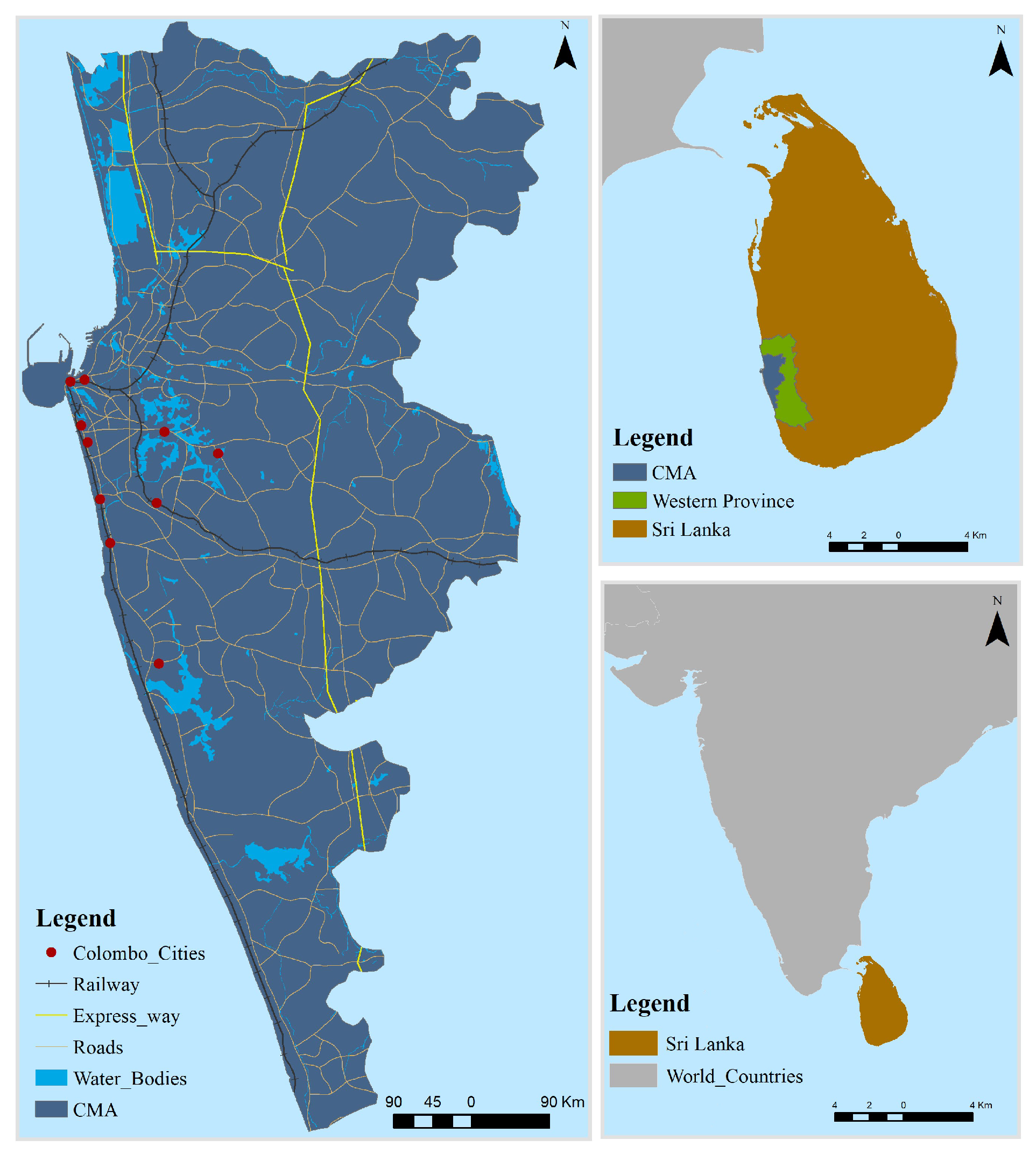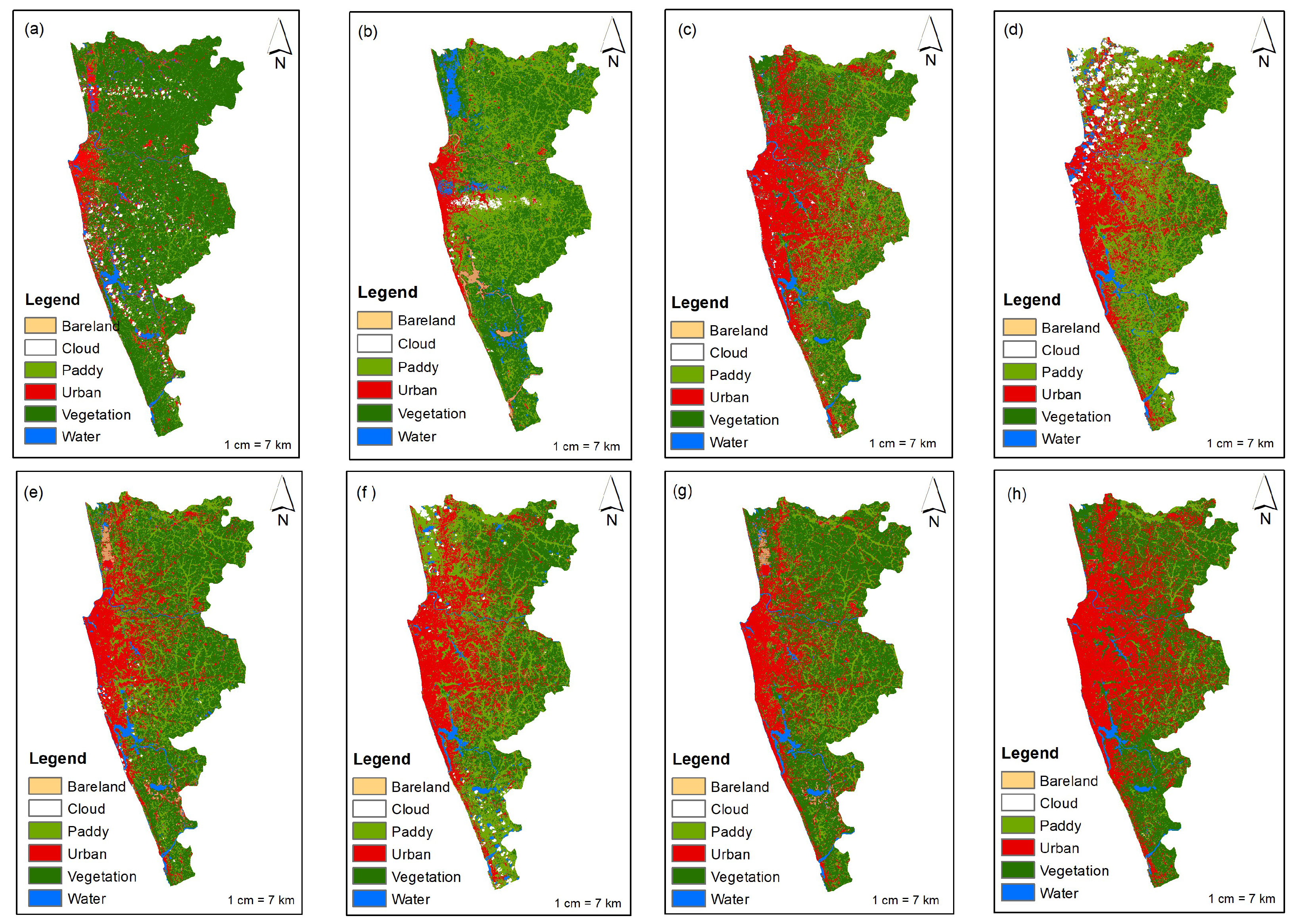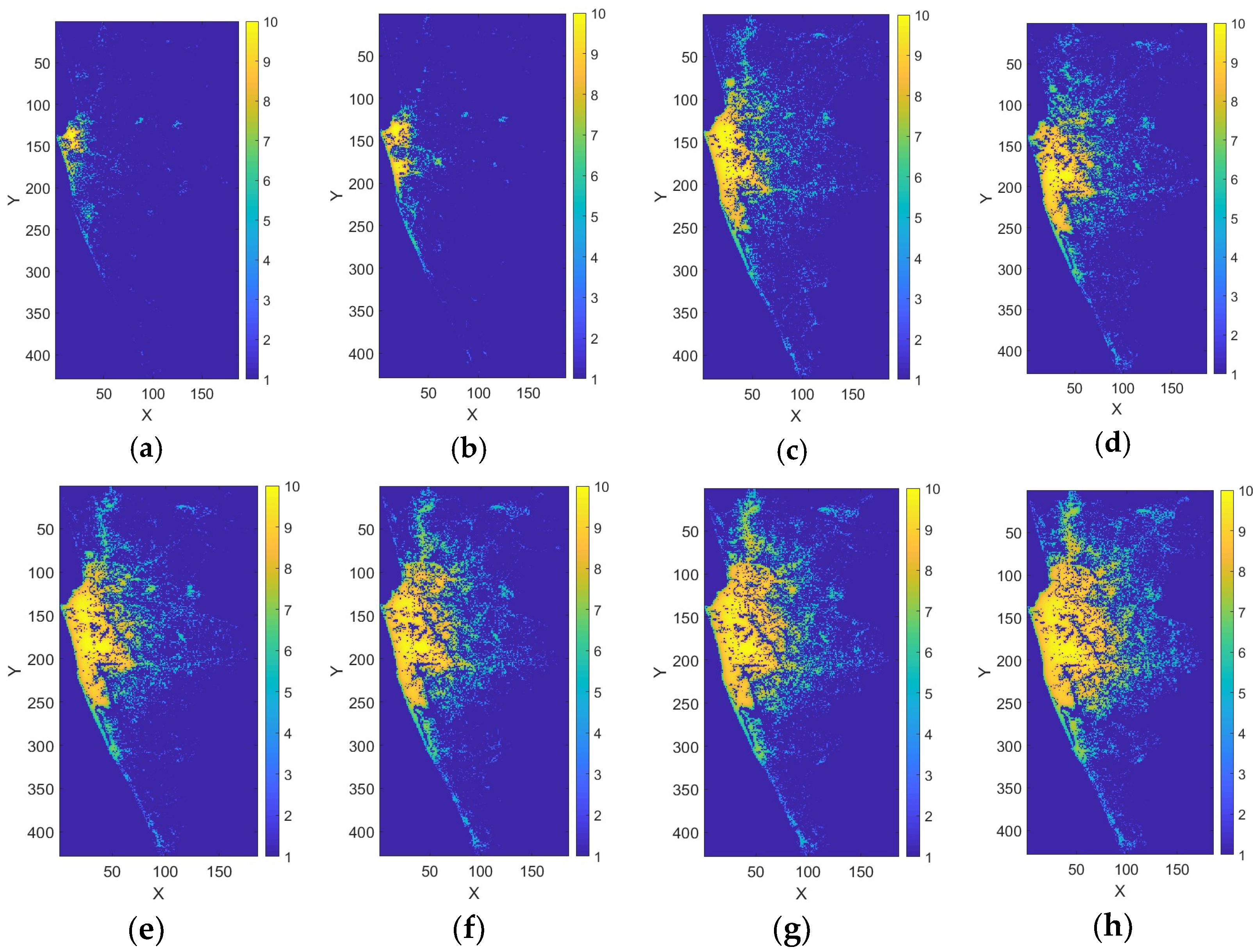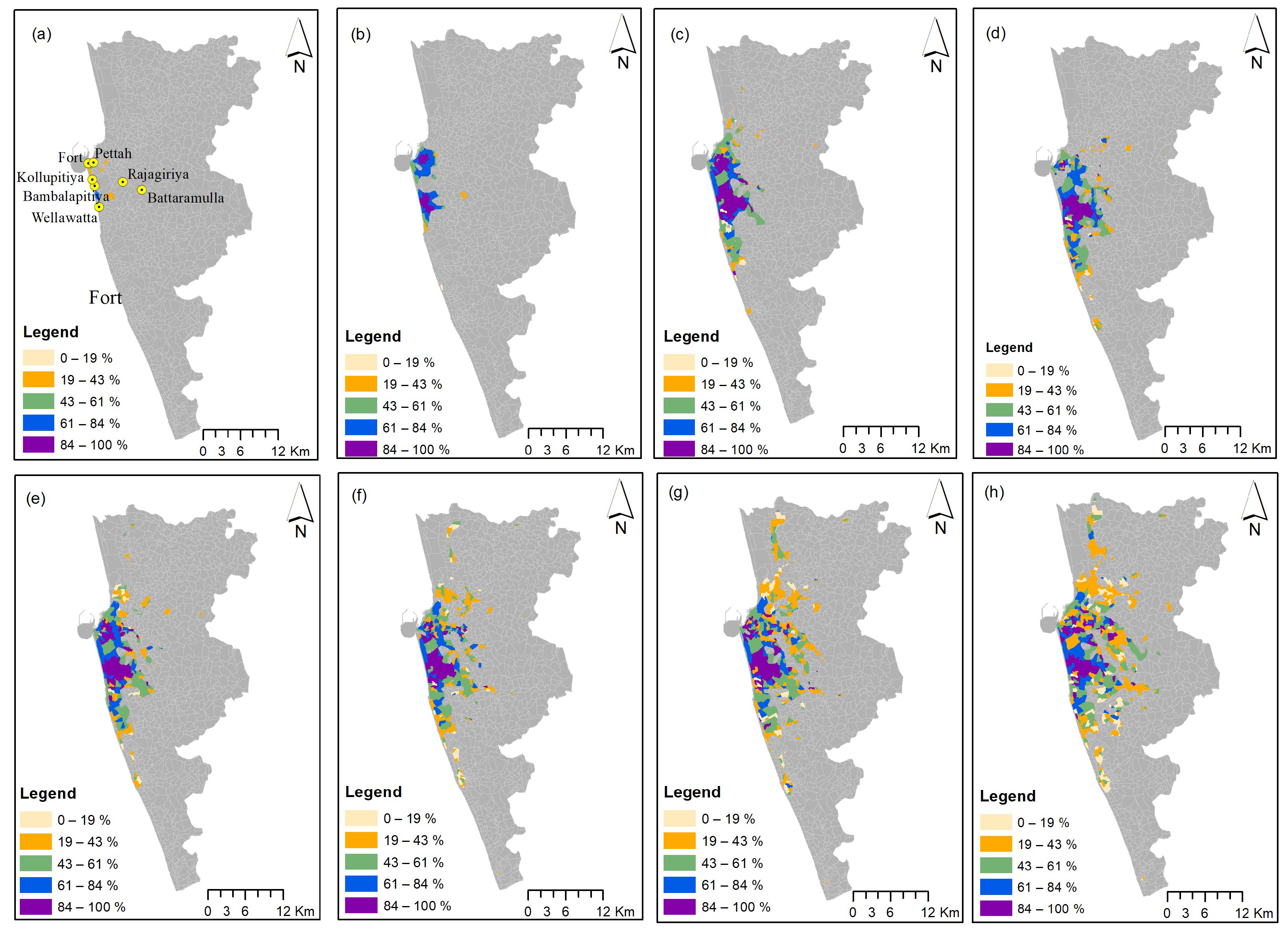Morphological and Functional Polycentric Urbanization in Colombo Metropolitan of Sri Lanka Using Time-Series Satellite Images from 1988–2022
Abstract
:1. Introduction
2. Materials and Methods
2.1. Study Area
2.2. Data Sources
2.3. Urban Land Cover Classification from Time-Series Images
2.4. Analysing the Dynamics of Urban Expansion
2.5. Characterizing the Urbanization Process
2.6. Identification of Morphological Polycentric Areas
2.7. Identification of Functional Polycentric Areas
3. Results
3.1. Urban Land Cover Changes in the CMA
3.2. The Urbanization Process in the CMA
3.3. Morphological Polycentric Areas
3.4. Functional Polycentric Areas
4. Discussion
5. Conclusions
Author Contributions
Funding
Data Availability Statement
Acknowledgments
Conflicts of Interest
References
- Chen, W.; Golubchikov, O.; Liu, Z. Measuring Polycentric Structures of Megaregions in China: Linking Morphological and Functional Dimensions. Environ. Plan. B Urban Anal. City Sci. 2020, 48, 239980832097468. [Google Scholar] [CrossRef]
- United Nations Department of Economic and Social Affairs (UNDESA). The World Urbanization Prospects: The 2018 Revisions; UNDESA: New York, NY, USA, 2019. [Google Scholar]
- Manesha, E.P.P.; Jayasinghe, A.; Kalpana, H.N. Measuring Urban Sprawl of Small and Medium Towns Using GIS and Remote Sensing Techniques: A Case Study of Sri Lanka. Egypt. J. Remote Sens. Space Sci. 2021, 24, 1051–1060. [Google Scholar] [CrossRef]
- Dadashpoor, H.; Azizi, P.; Moghadasi, M. Land Use Change, Urbanization, and Change in Landscape Pattern in a Metropolitan Area. Sci. Total Environ. 2019, 655, 707–719. [Google Scholar] [CrossRef] [PubMed]
- Abozeid, A.S.M.; AboElatta, T.A. Polycentric vs Monocentric Urban Structure Contribution to National Development. J. Eng. Appl. Sci. 2021, 68, 11. [Google Scholar] [CrossRef]
- Ding, Y.; Luo, Q. Polycentric Spatial Structure, Digital Economy and Urban Green Sustainable Development. J. Clean. Prod. 2024, 468, 143080. [Google Scholar] [CrossRef]
- Zhang, J.; Zhang, R.; Zhang, X.; Yuan, X. Polycentric Spatial Structure Evolution and Influencing Factors of the Kunming–Yuxi Urban Agglomeration: Based on Multisource Big Data Fusion. Land 2023, 12, 1340. [Google Scholar] [CrossRef]
- Chen, W.; Liu, W.; Ke, W.; Wang, N. Understanding Spatial Structures and Organizational Patterns of City Networks in China: A Highway Passenger Flow Perspective. J. Geogr. Sci. 2018, 28, 477–494. [Google Scholar] [CrossRef]
- Ma, M.; Lang, Q.; Yang, H.; Shi, K.; Ge, W. Identification of Polycentric Cities in China Based on NPP-VIIRS Nighttime Light Data. Remote Sens. 2020, 12, 3248. [Google Scholar] [CrossRef]
- Harris, C.D.; Ullman, E.L. The Nature of Cities. Ann. Am. Acad. Political Soc. Sci. 1945, 242, 7–17. [Google Scholar] [CrossRef]
- Yue, W.; Liu, Y.; Fan, P. Polycentric Urban Development: The Case of Hangzhou. Environ. Plan. A Econ. Space 2010, 42, 563–577. [Google Scholar] [CrossRef]
- Davoudi, S. Polycentricity in European Spatial Planning: From an Analytical Tool to a Normative Agenda. Eur. Plan. Stud. 2003, 11, 979–999. [Google Scholar] [CrossRef]
- Fujita, M.; Krugman, P.; Venables, A.J. The Spatial Economy: Cities, Regions, and International Trade; MIT Press: Cambridge, MA, USA, 1999. [Google Scholar] [CrossRef]
- Anas, A.; Kim, I. General Equilibrium Models of Polycentric Urban Land Use with Endogenous Congestion and Job Agglomeration. J. Urban Econ. 1996, 40, 232–256. [Google Scholar] [CrossRef]
- Anas, A.; Arnott, R.; Small, K.A. Urban Spatial Structure. J. Econ. Lit. 1998, 36, 1426–1464. [Google Scholar]
- Bartosiewicz, B.; Marcińczak, S. Investigating Polycentric Urban Regions: Different Measures—Different Results. Cities 2020, 105, 102855. [Google Scholar] [CrossRef]
- Alqhatani, M.; Setunge, S.; Mirodpour, S. Can a Polycentric Structure Affect Travel Behaviour? A Comparison of Melbourne, Australia and Riyadh, Saudi Arabia. J. Mod. Transp. 2014, 22, 156–166. [Google Scholar] [CrossRef]
- Siedentop, S.; Fina, S.; Krehl, A. Greenbelts in Germany's Regional Plans—An Effective Growth Management Policy? Landsc. Urban Plan. 2016, 145, 71–82. [Google Scholar] [CrossRef]
- Burger, M.J.; Van Der Knaap, B.; Wall, R.S. Polycentricity and the Multiplexity of Urban Networks. Eur. Plan. Stud. 2014, 22, 816–840. [Google Scholar] [CrossRef]
- Yue, W.; Wang, T.; Liu, Y.; Zhang, Q.; Ye, X. Mismatch of Morphological and Functional Polycentricity in Chinese Cities: An Evidence from Land Development and Functional Linkage. Land Use Policy 2019, 88, 104176. [Google Scholar] [CrossRef]
- Vaidyanathan, V.; King, R.A.; De Jong, M. Understanding Urban Transportation in India as Polycentric System. Policy Soc. 2013, 32, 175–185. [Google Scholar] [CrossRef]
- Alam, I.; Nahar, K.; Morshed, M.M. Measuring Urban Expansion Pattern Using Spatial Matrices in Khulna City, Bangladesh. Heliyon 2023, 9, e13193. [Google Scholar] [CrossRef]
- Pokhrel, K.P.; Ale, G.; Raut, A. Polycentric Settlement as A Sustainable Development Strategy: A Case of Baglung District, Nepal. Geogr. J. Nepal 2018, 11, 137–155. [Google Scholar] [CrossRef]
- He, X.; Cao, Y.; Zhou, C. Evaluation of Polycentric Spatial Structure in the Urban Agglomeration of the Pearl River Delta (PRD) Based on Multi-Source Big Data Fusion. Remote Sens. 2021, 13, 3639. [Google Scholar] [CrossRef]
- Xie, Z.; Ye, X.; Zheng, Z.; Li, D.; Sun, L.; Li, R.; Benya, S. Modeling Polycentric Urbanization Using Multisource Big Geospatial Data. Remote Sens. 2019, 11, 310. [Google Scholar] [CrossRef]
- Subasinghe, S.; Wang, R.; Simwanda, M.; Murayama, Y.; Vitanova, L.L. Neighborhood Dynamics of Urban Expansion Based on Morphological Spatial Pattern Analysis and Geospatial Techniques: A Case Study of the Colombo Metropolitan Area, Sri Lanka. Asian Geogr. 2022, 39, 155–175. [Google Scholar] [CrossRef]
- UN Habitat. State of Sri Lankan Cities Report; UN Habitat: Colombo, Sri Lanka, 2018; Available online: https://unhabitat.lk/wp-content/uploads/2018/12/SoSLC_Report_Final_Low-r.pdf (accessed on 12 June 2023).
- Weeraratne, B. Re-Defining Urban Areas in Sri Lanka; Institute of Policy Studies of Sri Lanka: Colombo, Sri Lanka, 2016. [Google Scholar]
- Subasinghe, S.; Estoque, R.; Murayama, Y. Spatiotemporal Analysis of Urban Growth Using GIS and Remote Sensing: A Case Study of the Colombo Metropolitan Area, Sri Lanka. ISPRS Int. J. Geo-Inf. 2016, 5, 197. [Google Scholar] [CrossRef]
- Munasinghe, J. Policies and Issues in Urban Development in Sri Lanka: An Examination of the Inter-Domain Gaps. Sri Lanka J. Soc. Sci. 2014, 35, 9. [Google Scholar] [CrossRef]
- Sri Lanka Central Bank. Economic and Social Statistics 2023; Sri Lanka Central Bank: Colombo, Sri Lanka, 2023. Available online: https://www.cbsl.gov.lk/en/publications/other-publications/statistical-publications/economic-and-social-statistics-of-sri-lanka/ess-2023 (accessed on 12 June 2023).
- Wickramaarachchi, N.C.; Rathnamalala, T. Consequences of the State Land Alienation Programme in Sri Lanka. J. Soc. Sci. Humanit. Rev. 2022, 7, 248–270. [Google Scholar] [CrossRef]
- Lv, Y.; Zhou, L.; Yao, G.; Zheng, X. Detecting the True Urban Polycentric Pattern of Chinese Cities in Morphological Dimensions: A Multiscale Analysis Based on Geospatial Big Data. Cities 2021, 116, 103298. [Google Scholar] [CrossRef]
- Yang, Z.; Chen, Y.; Zheng, Z.; Wu, Z. Identifying China’s Polycentric Cities and Evaluating the Urban Centre Development Level Using Luojia-1A Night-Time Light Data. Ann. GIS 2022, 28, 185–195. [Google Scholar] [CrossRef]
- Hogg, C. Sri Lanka: Prospects for Reform and Reconciliation; Asia Programme Paper; Chatham House: London, UK, 2010; Available online: https://www.chathamhouse.org/sites/default/files/1011pp_srilanka_0.pdf (accessed on 12 June 2023).
- Phan, T.N.; Kuch, V.; Lehnert, L.W. Land Cover Classification Using Google Earth Engine and Random Forest Classifier—The Role of Image Composition. Remote Sens. 2020, 12, 2411. [Google Scholar] [CrossRef]
- Liu, X.; Li, X.; Chen, Y.; Tan, Z.; Li, S.; Ai, B. A New Landscape Index for Quantifying Urban Expansion Using Multi-Temporal Remotely Sensed Data. Landsc. Ecol. 2010, 25, 671–682. [Google Scholar] [CrossRef]
- Yang, C.; Li, Q.; Hu, Z.; Chen, J.; Shi, T.; Ding, K.; Wu, G. Spatiotemporal Evolution of Urban Agglomerations in Four Major Bay Areas of the US, China, and Japan from 1987 to 2017: Evidence from Remote Sensing Images. Sci. Total Environ. 2019, 671, 232–247. [Google Scholar] [CrossRef] [PubMed]
- Liao, K.; Huang, W.; Wang, C.; Wu, R.; Hu, Y. Spatio-Temporal Evolution Features and Impact Factors of Urban Expansion in Underdeveloped Cities: A Case Study of Nanchang, China. Land 2022, 11, 1799. [Google Scholar] [CrossRef]
- Yang, Y.; Liu, Y.; Li, Y.; Du, G. Quantifying Spatio-Temporal Patterns of Urban Expansion in Beijing During 1985–2013 with Rural-Urban Development Transformation. Land Use Policy 2018, 74, 220–230. [Google Scholar] [CrossRef]
- Fei, W.; Zhao, S. Urban Land Expansion in China's Six Megacities from 1978 to 2015. Sci. Total Environ. 2019, 664, 60–71. [Google Scholar] [CrossRef]
- Zhao, S.; Zhou, D.; Zhu, C.; Qu, W.; Zhao, J.; Sun, Y.; Huang, D.; Wu, W.; Liu, S. Rates and Patterns of Urban Expansion in China’s 32 Major Cities Over the Past Three Decades. Landsc. Ecol. 2015, 30, 1541–1559. [Google Scholar] [CrossRef]
- Tobler, W. A Computer Movie Simulating Urban Growth in the Detroit Region. Econ. Geogr. 1970, 46, 234–240. [Google Scholar] [CrossRef]
- Tobler, W. Three Presentations on Geographical Analysis and Modeling; Technical Report 1993; National Center for Geographic Information and Analysis: Santa Barbara, CA, USA, 1993. [Google Scholar]
- Wilson, A.G. A Statistical Theory of Spatial Distribution Models. Transp. Res. 1967, 1, 253–269. [Google Scholar] [CrossRef]
- Yang, Z.; Chen, Y.; Guo, G.; Zheng, Z.; Wu, Z. Using Nighttime Light Data to Identify the Structure of Polycentric Cities and Evaluate Urban Centers. Sci. Total Environ. 2021, 780, 146586. [Google Scholar] [CrossRef]
- Cai, J.; Huang, B.; Song, Y. Using Multi-Source Geospatial Big Data to Identify the Structure of Polycentric Cities. Remote Sens. Environ. 2017, 202, 210–221. [Google Scholar] [CrossRef]
- Chen, Z.; Yu, B.; Song, W.; Liu, H.; Wu, Q.; Shi, K.; Wu, J. A New Approach for Detecting Urban Centers and Their Spatial Structure with Nighttime Light Remote Sensing. IEEE Trans. Geosci. Remote Sens. 2017, 55, 6305–6319. [Google Scholar] [CrossRef]
- Li, H.; Liu, Y.; Zhang, H.; Xue, B.; Li, W. Urban Morphology in China: Dataset Development and Spatial Pattern Characterization. Sustain. Cities Soc. 2021, 71, 102981. [Google Scholar] [CrossRef]
- Yu, H.; Yang, J.; Li, T.; Jin, Y.; Sun, D. Morphological and Functional Polycentric Structure Assessment of Megacity: An Integrated Approach with Spatial Distribution and Interaction. Sustain. Cities Soc. 2022, 80, 103800. [Google Scholar] [CrossRef]
- Sevtsuk, A.; Mekonnen, M. Urban Network Analysis. A New Toolbox ArcGIS. Int. J. Geomat. Spat. Anal. 2012, 22, 287–305. [Google Scholar] [CrossRef]
- Amarawickrama, S.; Singhapathirana, P.; Rajapaksha, N. Defining Urban Sprawl in the Sri Lankan Context: With Special Reference to the Colombo Metropolitan Region. J. Asian Afr. Stud. 2015, 50, 590–614. [Google Scholar] [CrossRef]
- JICA. CoMTrans Urban Transport Master Plan; JICA: Tokyo, Japan, 2014; Available online: https://openjicareport.jica.go.jp/pdf/12176665.pdf (accessed on 24 April 2023).
- Ellis, P.; Roberts, M. Leveraging Urbanization in South Asia: Managing Spatial Transformation for Prosperity and Livability; World Bank: Washington, DC, USA, 2015; Available online: http://hdl.handle.net/10986/22549 (accessed on 12 June 2023).
- Kelegama, S.; Corea, G. Economic Policy in Sri Lanka: Issues and Debates; Sage Publications: New Delhi, India; Thousand Oaks, CA, USA; London, UK, 2004; ISBN 0-7619-3278-X (Hb). [Google Scholar]
- Lityński, P.; Serafin, P. Polynuclearity as a Spatial Measure of Urban Sprawl: Testing the Percentiles Approach. Land 2021, 10, 732. [Google Scholar] [CrossRef]
- García-López, M.-À.; Muñiz, I. Employment Decentralisation: Polycentricity or Scatteration? The Case of Barcelona. Urban Stud. 2010, 47, 3035–3056. [Google Scholar] [CrossRef]
- Sun, T.; Han, Z.-F.; Wang, L.; Li, G. Suburbanization and Sub-Centering of Population in the Beijing Metropolitan Area: A Nonparametric Analysis. Chin. Geogr. Sci. 2012, 22, 472–482. [Google Scholar] [CrossRef]
- Hao, F.; Lu, M.; Yu, T.; Wang, S. Identification and Characterization of Urban Polycentric Structure Based on Points of Interest in Shenyang, China. Growth Chang A J. Urban Reg. Policy 2024, 55, e12697. [Google Scholar] [CrossRef]
- Xiao, Y.; Wang, Y.; Miao, S.; Niu, X. Assessing Polycentric Urban Development in Shanghai, China, with Detailed Passive Mobile Phone Data. Environ. Plan. B Urban Anal. City Sci. 2021, 49, 239980832098230. [Google Scholar] [CrossRef]
- Burger, M.; Meijers, E. Form follows function? Linking morphological and functional polycentricity. Urban Studies 2012, 49, 1127–1149. [Google Scholar] [CrossRef]
- Lin, Y.; Zhang, H.; Li, G.; Wang, T.; Wan, L.; Lin, H. Improving impervious surface extraction with shadow-based sparse representation from optical, SAR, and LiDAR data. IEEE J. Sel. Top. Appl. Earth Obs. Remote Sens. 2019, 12, 2417–2428. [Google Scholar] [CrossRef]
- Wang, T.; Zhang, H.; Lin, H.; Jia, X. A sparse representation method for a priori target signature optimization in hyperspectral target detection. IEEE Access 2017, 6, 3408–3424. Available online: https://ieeexplore.ieee.org/document/8110614 (accessed on 2 September 2024). [CrossRef]
- Wang, Y.; Niu, X. Polycentricity Measurement of China’s Urban Agglomerations Considering Internal and External Connections. Front. Urban Rural Plan. 2023, 1, 19. [Google Scholar] [CrossRef]







| Index | Definition | Urban Center | Non-Urban Center |
|---|---|---|---|
| Area (A) | A = N × PA | ≤12 km | <12 km |
| Standard Deviation | >>0 | ≈0 | |
| Elongation (EL) | ELA = LLA/SLA | <5 | ≥5 |
| Period | Increased Area | Urban Area | AI (km2) | UEI (%) | Stage |
|---|---|---|---|---|---|
| 1988–1992 | 98.037 | 98.037 | 19.6074 | 0.191 | Low-strength |
| 1992–1997 | 63 | 161.037 | 12.6 | 0.942 | High-strength |
| 1997–2002 | 24.196 | 185.233 | 4.8392 | 0.477 | Medium-strength |
| 2002–2007 | 28.688 | 213.921 | 5.7376 | 0.566 | High-strength |
| 2007–2012 | 69.025 | 282.946 | 13.805 | 0.611 | High-strength |
| 2012–2017 | 4.563 | 287.509 | 0.9126 | 0.090 | Low-strength |
| 2017–2022 | 19.502 | 307.011 | 3.9004 | 0.385 | Medium-strength |
Disclaimer/Publisher’s Note: The statements, opinions and data contained in all publications are solely those of the individual author(s) and contributor(s) and not of MDPI and/or the editor(s). MDPI and/or the editor(s) disclaim responsibility for any injury to people or property resulting from any ideas, methods, instructions or products referred to in the content. |
© 2024 by the authors. Licensee MDPI, Basel, Switzerland. This article is an open access article distributed under the terms and conditions of the Creative Commons Attribution (CC BY) license (https://creativecommons.org/licenses/by/4.0/).
Share and Cite
Fonseka, H.P.U.; Premasiri, H.M.R.; Chaminda, S.P.; Zhang, H. Morphological and Functional Polycentric Urbanization in Colombo Metropolitan of Sri Lanka Using Time-Series Satellite Images from 1988–2022. Sustainability 2024, 16, 7816. https://doi.org/10.3390/su16177816
Fonseka HPU, Premasiri HMR, Chaminda SP, Zhang H. Morphological and Functional Polycentric Urbanization in Colombo Metropolitan of Sri Lanka Using Time-Series Satellite Images from 1988–2022. Sustainability. 2024; 16(17):7816. https://doi.org/10.3390/su16177816
Chicago/Turabian StyleFonseka, H. P. U., H. M. R. Premasiri, S. P. Chaminda, and Hongsheng Zhang. 2024. "Morphological and Functional Polycentric Urbanization in Colombo Metropolitan of Sri Lanka Using Time-Series Satellite Images from 1988–2022" Sustainability 16, no. 17: 7816. https://doi.org/10.3390/su16177816






